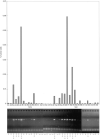Sensitive PCR method for the detection and real-time quantification of human cells in xenotransplantation systems
- PMID: 12439725
- PMCID: PMC2408903
- DOI: 10.1038/sj.bjc.6600573
Sensitive PCR method for the detection and real-time quantification of human cells in xenotransplantation systems
Abstract
The sensitive detection of human cells in immunodeficient rodents is a prerequisite for the monitoring of micrometastasis of solid tumours, dissemination of leukaemic cells, or engraftment of haematological cells. We developed a universally applicable polymerase chain reaction method for the detection of a human-specific 850-bp fragment of the alpha-satellite DNA on human chromosome 17. The method allows the detection of one human cell in 10(6) murine cells and could be established as both, a conventional DNA polymerase chain reaction-assay for routine screening, and a quantitative real-time polymerase chain reaction-assay using TaqMan-methodology. It was applied to the following xenotransplantation systems in SCID and NOD/SCID mice: (1) In a limiting dilution assay, cells of the MDA-MB 435 breast carcinoma were injected into the mammary fat pad of NOD/SCID mice. It could be shown that 10 cells mouse(-1) were sufficient to induce a positive polymerase chain reaction signal in liver and lung tissue 30 days after transplantation as an indicator for micrometastasis. At this time a palpable tumour was not yet detectable in the mammary fat pad region. (2) Cells of a newly established human acute lymphatic leukaemia were administered intraperitoneally to SCID mice. These cells apparently disseminated and were detectable as early as day 50 in the peripheral blood of living mice, while the leukaemia manifestation was delayed by day 140. (3) In a transplantation experiment using mature human lymphocytes we wanted to standardise conditions for a successful survival of these cells in NOD/SCID mice. It was established that at least 5 x 10(7) cells given intravenously were necessary and that the mice had to be conditioned by 2 Gy body irradiation to get positive polymerase chain reaction bands in several organs. (4) Engraftment studies with blood stem cells originating from cytapheresis samples of tumour patients or from cord blood were undertaken in NOD/SCID mice in order to define conditions of successful engraftment and to use this model for further optimisation strategies. The polymerase chain reaction method presented allowed a reliable prediction of positive engraftment and agreed well with the results of immunohistochemical or FACS analysis. All together, the polymerase chain reaction method developed allows a sensitive and reliable detection of low numbers of human cells in immunodeficient hosts. In combination with real-time (TaqMan) technique it allows an exact quantification of human cells. As this method can be performed with accessible material of living animals, follow up studies for the monitoring of therapeutic interventions are possible in which the survival time of mice as evaluation criteria can be omitted.
Figures





References
-
- AillesLEGerhardBKawagoeHHoggeDE1999Growth characteristics of acute myelogenous leukaemia progenitors that initiate malignant hematopoiesis in nonobese diabetic/severe combined immunodeficient mice Blood 9417611772 - PubMed
-
- BosmaGCCusterRPBosmaMJ1983A severe combined immunodeficiency mutation in the mouse Nature 301527530 - PubMed
-
- FichtnerIGoanSRBeckerMBaldyCBorgmannAvon StackelbergAHenzeH(eds)1999Transplantation of human haematopoietic or leukaemic cells into SCID and NOD/SCID miceInRelevance of tumor models for anticancer drug development Vol 54Fiebig, HH, Burger, AM (eds)pp207217Freiberg, Germany: Karger
-
- FinnOJJeromeKRHendersonRAPecherGDomenechNMagarin-BlanderJBarrat-BoyesSM1995MUC-1 epithelial tumor mucin-based immunity and cancer vaccines Immunol Reviews 1456189 - PubMed
-
- FodstadØAamdalSMcMenaminMNeslandJMPihlA1988A new experimental metastasis model in athymic nude mice, the human malignant melanoma LOX Int J Cancer 41442449 - PubMed
MeSH terms
Substances
LinkOut - more resources
Full Text Sources
Other Literature Sources
Research Materials
Miscellaneous

